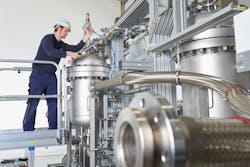Siemens Gamesa produces Green Hydrogen in island mode at H2 site in Denmark
Siemens Gamesa reported it has reached a new milestone at its Brande Hydrogen pilot project site in Denmark.
The renewable energy company said It has produced the first green hydrogen in its testing and commissioning phase in “island mode” and distributed it to hydrogen stations across the country through project partner Everfuel. The firm has installed a battery, turbine and electrolyzer set up at the site, connecting it to an existing Siemens Gamesa SWT 3.0-113 DD wind turbine.
The wind turbine has an electrolyzer stack from Green Hydrogen Systems. The combination of a battery, turbine and an electrolyzer will ensure a reliable supply of green hydrogen. It has the potential to produce industrial-scale volumes of green hydrogen and expand to other existing wind projects. The setup can also connect to the grid, ensuring greater flexibility in electricity supply.
Danish authorities had granted the site an official regulatory test zone status, facilitating the site to operate outside the existing electricity regulations. It facilitated the research and development of an island-mode capable system of offshore hydrogen production at the turbine level. Learnings from this project can be shared with partners to build the use case for the large scale production of green hydrogen.
About the Author
EnergyTech Staff
Rod Walton is senior editor for EnergyTech.com. He has spent 17 years covering the energy industry as a newspaper and trade journalist.
Walton formerly was energy writer and business editor at the Tulsa World. Later, he spent six years covering the electricity power sector for Pennwell and Clarion Events. He joined Endeavor and EnergyTech in November 2021.
He can be reached at [email protected].
EnergyTech is focused on the mission critical and large-scale energy users and their sustainability and resiliency goals. These include the commercial and industrial sectors, as well as the military, universities, data centers and microgrids.
Many large-scale energy users such as Fortune 500 companies, and mission-critical users such as military bases, universities, healthcare facilities, public safety and data centers, shifting their energy priorities to reach net-zero carbon goals within the coming decades. These include plans for renewable energy power purchase agreements, but also on-site resiliency projects such as microgrids, combined heat and power, rooftop solar, energy storage, digitalization and building efficiency upgrades.
